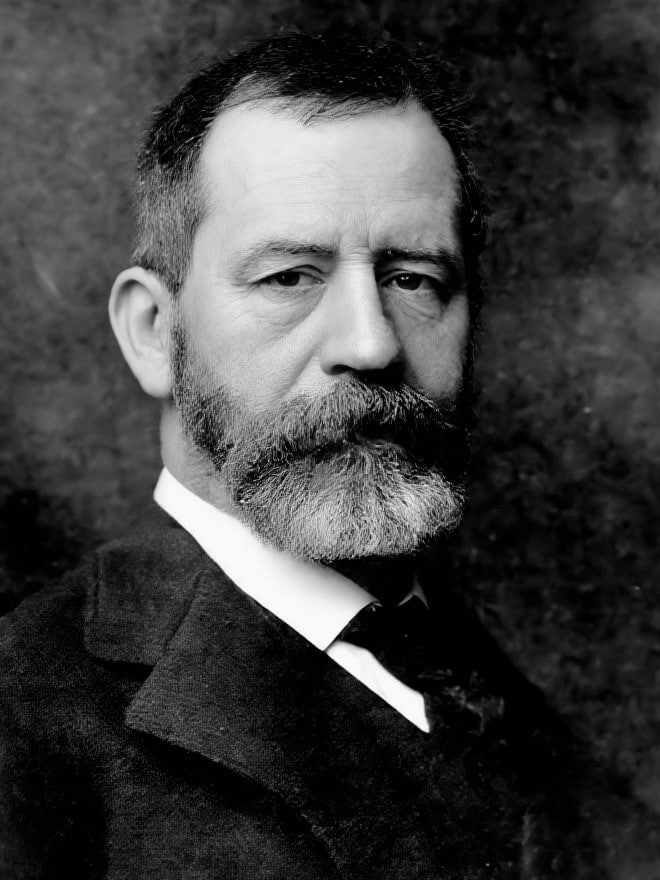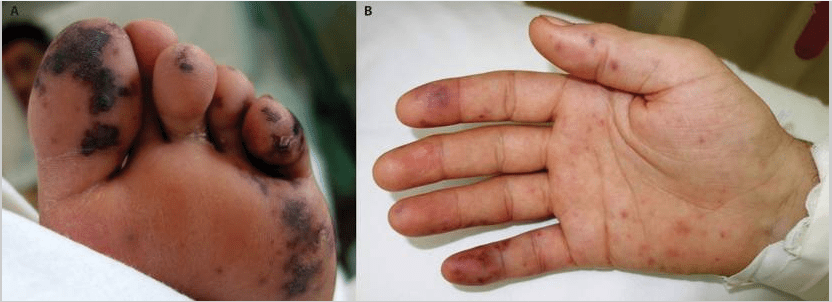Edward Janeway

Edward Gamaliel Janeway (1841-1911) was an American physician and pathologist.
A product of the Civil War medical service and rigorous autopsy-based training at Bellevue Hospital, Janeway helped define the emerging specialty of internal medicine in the United States. He held numerous academic and public health positions, was revered for his diagnostic acumen, and left a legacy of methodical, anatomy-based clinical reasoning. Though he published sparingly, his influence was profound through bedside teaching and institutional reform.
Janeway was a pioneering American physician, educator, and diagnostician, remembered today for the “Janeway lesions” described in infective endocarditis. The eponym honours Janeway’s commitment to clinical-pathological correlation and meticulous observation—a diagnostic legacy reinforced through teaching and consultation rather than prolific writing.
Janeway also contributed significantly to early clinical neurology, publishing at least nine papers on neurologic complications of infections, including endocarditis, cerebral embolism, and syphilitic meningitis. His observations linked febrile states, embolic phenomena, and neurologic deficits—prefiguring the integrated approach of modern neurocritical care.
Biography
- 1841 – Born August 31 near New Brunswick, New Jersey
- 1860 – AB from Rutgers College; matriculated at College of Physicians and Surgeons, New York
- 1862–1863 – Served as medical cadet during Civil War at U.S. Army Hospital, Newark, NJ
- 1864 – MD, College of Physicians and Surgeons in New York City; appointed house staff, Bellevue Hospital (served until 1866)
- 1866–1872 – Curator and pathologist at Bellevue Hospital
- 1868–1872 – Visiting physician, Charity Hospital; 1870, appointed chief of staff to reform hospital operations
- 1872 – Appointed visiting physician and Professor of Pathological Anatomy, Bellevue Hospital Medical College
- 1875–1881 – Commissioner of Health for New York City; instrumental in public health reforms including the first contagious diseases hospital in Manhattan
- 1881 – Appointed Professor of Diseases of the Mind and Nervous System; succeeded Austin Flint (1812-1886) as Professor of Medicine
- 1886 – Founding member of the Association of American Physicians
- 1892 – Resigned from Bellevue posts after policy disagreements
- 1898 – Became Dean of the merged University and Bellevue Hospital Medical College
- 1899 – Published article describing distinctive skin hemorrhages in endocarditis (later termed Janeway lesions)
- 1900 – President, Association of American Physicians
- 1907 – Awarded LL.D. by Princeton University
- 1910 – President, National Association for the Study and Prevention of Tuberculosis
- 1911 – Died February 10 at Summit, New Jersey
Medical Eponyms
Janeway lesion (1899)
Janeway lesions are small nontender, erythematous or hemorrhagic macules typically located on the palms and soles; associated with acute infective endocarditis. Unlike Osler nodes (which are tender), Janeway lesions are characteristically painless and blanching. Histologically, Janeway lesions show neutrophilic microabscesses with bacterial colonies, supporting their embolic-infectious pathogenesis.
Janeway noted these small haemorrhagic lesions in patients with malignant endocarditis. The term “Janeway lesions” was later introduced by Emanuel Libman (1872-1946), who had trained under Janeway and acknowledged the diagnostic value of these signs.

1882 – Janeway described acute ulcerative endocarditis as mimicking both brain disease and typhoid fever in his paper “Cases Bearing on the Diagnosis, and Localization of Cerebral Diseases, and Their Difficulties“. He noted that embolic fragments from heart valve vegetations could lodge in the brain or skin, causing petechiae and neurologic symptoms such as hemiplegia or aphasia. In particular he noted that petechiae and nodular haemorrhages in the palms and soles were associated with acute ulcerative endocarditis.
We have in this, as you know, the development of soft masses on the heart-valves, which as a rule are ulcerated, and then the little fragments from these pass as emboli to the different organs, giving rise in the skin to petechias from the obstruction of small arteries
These clinical insights predated the famous Gulstonian Lectures of Sir William Osler (1849-1919), and formed the basis of Janeway’s attention to subtle skin signs.
1899 – Edward Janeway described the lesion in the context of separating “malignant” (acute) endocarditis from other infectious disorders
In trying to determine whether a given case is more probably due to endocarditis or to another malignant process I have found that attention to the position of the hemorrhages is at times very helpful. Several times I have noted numerous small hemorrhages with slight nodular character in the palms of the hand and soles of the feet, when possibly the arms and legs had but a scanty crop in malignant endocarditis, whereas this has not been my experience with processes likely to be mistaken for it.
1906 – Emanuel Libman, a student of Janeway, applied the eponym ‘Janeway lesion’. Libman pointed out that these lesions were not tender, in contrast to the exquisitely painful Osler node.
I would like to refer to a point which has been of great value… “the small hemorrhages in the palms and soles with slightly nodular character” I learned from Dr. Janeway when I had the privilege of serving under him…(keep) a sharp lookout for them as they will often direct attention to an acute endocarditis to which there was no other clue.
1923 – Libman originally considered Janeway lesions to be pathognomonic for acute bacterial endocarditis but later remarked that he had also seen them in three patients with subacute bacterial endocarditis.
Embolic lesions occur with great frequency in the acute and subacute bacterial cases. They consist of petechiae, Janeway lesions, Osler (tender cutaneous) nodes and purpura
Major Publications
- Janeway EG. The necessity of post-mortem examinations. Medical Record 1872; 7: 536–540
- Janeway EG. Some interesting cases of nervous disease. The American psychological journal. 1875;ii:51–61
- Janeway EG. The Progress of Medicine (Case reports). New York medical journal. 1877
- Janeway EG. Cerebral embolism. The Medical and surgical reporter. 1877; 36: 463-465.
- Janeway EG. Clinical lecture on syphilitic meningitis. Hospital Gazette and Archives of Clinical Surgery. 1877; 2(8): 252-254
- Janeway EG. Post-paralytic chorea. Hospital Gazette and Archives of Clinical Surgery. 1878; 4: 366.
- Janeway EG. Cerebro-spinal meningitis (Autopsy). New York Medical Journal. 1880; 32: 60-61
- Janeway EG. Tumor of the pons varolii (glioma mucosum). New York Medical Journal. 1880; 32: 66-67
- Janeway EG. Cases Bearing on the Diagnosis, and Localization of Cerebral Diseases, and Their Difficulties. The Transactions of the New York Academy of Medicine 1883; II(3): 167-188
- Janeway EG. Some Reflections upon Therapeutics and the Materia Medica. Transactions of the New York Academy of Medicine 1895; 12: 67-88
- Janeway EG. Certain clinical observations upon heart disease. Medical News. 1899; 75: 257-262 [Janeway lesions]
References
Biography
- Edward Gamaliel Janeway. Medical Record (NY) 1911; 79: 684-685.
- Edward Gamaliel Janeway. New York Medical Journal 1911; 93: 331
- Edward G. Janeway. Boston medical and surgical journal. 1911; 164: 249
- Knopf SA. Dr Edward G. Janeway. New York Medical Journal 1912; 95: 105-107
- Janeway TC. Edward Gamaliel Janeway. In: American Medical Biographies (Eds. Kelly HA, Burrage WL) 1920: 610–614
Eponymous terms
- Libman E. On some experiences with blood cultures in the study of bacterial infection. Johns Hopkins Hospital Bulletin. 1906; 17: 215-228
- Prutkin JM, Fye WB. Edward G. Janeway, clinician and pathologist. Clinical Cardiology, 2006; 29(8): 376–377.
- Wijdicks EFM. Janeway and His Neurology of Acute Infectious Disease. Neurocrit Care. 2024 Jan 26.
Eponym
the person behind the name
Dr. Elaine Rabin is an Associate Professor of Emergency Medicine at the Icahn School of Medicine at Mount Sinai, and the Program Director for the Residency in Emergency Medicine at Mount Sinai Hospital | Sinai EM |
BA MA (Oxon) MBChB (Edin) FACEM FFSEM. Emergency physician, Sir Charles Gairdner Hospital. Passion for rugby; medical history; medical education; and asynchronous learning #FOAMed evangelist. Co-founder and CTO of Life in the Fast lane | On Call: Principles and Protocol 4e| Eponyms | Books |

